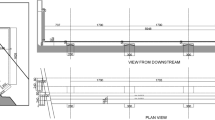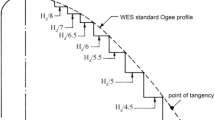Abstract
This study presents the results of physical and numerical modeling of the effect of bed roughness height of chute spillways on the cavitation index. A 1:50-scale physical hydraulic model of the chute spillway of Surk Dam was constructed at the hydraulic laboratory of Shahrekord University, Iran. The experiments were conducted for different flow rates and the parameters of pressure, velocity, and flow depth in 26 positions along the chute. Finally, the ANSYS-FLUENT model was calibrated in the chute spillway using the experimental data by assumptions of two-phase volume of fluid and k–ε (RNG) turbulence models. The cavitation index in different sections of the chute spillway was calculated for different values of bed roughness including the roughness heights of 1, 2, and 2.5 mm. Results showed that the minimum values of the cavitation index were 0.2906, 0.2733, and 0.2471 for the roughness heights of 1, 2, and 2.5 mm, respectively. The statistical significance analysis showed that reducing the roughness height from 2.5 to 1 mm would not change significantly the value of the cavitation index at 95% confidence interval.











Similar content being viewed by others
Notes
US Army Corps of Engineers.
Re-Normalisation Group.
References
Bhosekar VV, Jothiprakash V, Deolalikar PB (2012) Orifice spillway aerator: hydraulic design. Journal of Hydraulic Engineering 138(6):563–572. https://doi.org/10.1061/(ASCE)HY.1943-7900.0000548
Fiedler W (2016) Managing dam safety risks related to hydraulic of the accuracy. In: B Crookston, B Tullis (eds) Hydraulic structures and water system management. 6th IAHR international symposium on hydraulic structures, Portland, OR, pp 508–518. https://doi.org/10.15142/t3720628160853
Lee W, Hoopes JA (1996) Prediction of cavitation damage for spillways. J Hydraul Eng 122(9):481–488. https://doi.org/10.1061/(ASCE)0733-9429(1996)122:9(481)
Inozemtsev YP (1969) Cavitation destruction of concrete and protective facings under natural conditions. Power Technology and Engineering 3(1):24–29
Kells JA, Smith CD (1991) Reduction of cavitation on spillways by induced air entrainment. Can J Civ Eng 18(3):358–377. https://doi.org/10.1139/l91-047
Rajasekhar P, Santhosh YVG, Soma Sekhar S (2014) Physical and numerical model studies on cavitation phenomenon—a study on Nagarjuna Sagar spillway. International Journal of Recent Development in Engineering and Technology 2(1):2347–6435
Heiner BJ, Shupe ChC (2017) El Vado Dam—service spillway modification-physical model study. Hydraulic Laboratory Techniques, U.S. Department of the Interior, Report No. HL-2017-02
Nazari O, Jabbari E, Sarkardeh H (2015) Dynamic pressure analysis at chute flip buckets of five dam model studies. Int J Civ Eng Trans A Civ Eng 13(1):45–54
Ozturk M, Aydin MC (2009) Verification of a 3-D numerical model for spillway aerator. Math Comput Appl 14(1):21–30
Dehdar-behbahani S, Parsaie A (2016) Numerical modeling of flow pattern in dam spillway’s guide wall Case study: Balaroud dam, Iran. Alexandria Eng J 55(1):467–473. https://doi.org/10.1016/j.aej.2016.01.006
Eskanadari Sabzi A, Afrous A (2015) Examining the effect of cavitation on crest spillway using Ansys-fluent software. J Sci Res Dev 2(5):303–308
Kamanbedast AA, Bahmani M, Aghamajidi R (2014) The effect of surface roughness on discharge coefficient and cavitations of ogee spillways using physical models. J Appl Sci Agric 9(6):2442–2448
Ghodousi H, Abedini AM (2016) Simultaneous effect of convergence and reducing slope of chute construction on the economic of the plan and cavitation Index (Case study: Daharan Dam). Open J Geol 6(7):617–625. https://doi.org/10.4236/ojg.2016.67048
Teng PH (2017) CFD modelling of two-phase flows at spillway aerator. TRITA-HYD, No. 02, p 56
Naseri F, Sarkardeh H, Jabbari E (2018) Effect of inlet flow condition on hydrodynamic parameters of stilling basins. Acta Mech 229(3):1415–1428. https://doi.org/10.1007/s00707-017-2069-z
Chakib B (2018) Numerical study of turbulent flow for moderate-slope stepped spillways. Malays J Civ Eng 30(1):57–68
ANSYS FLUENT (2013) 15.0 theory guide
Falvey H (1990) Cavitation in chute and spillway. Bureau of Recamation. Denever Co. Use
Boes R, Hager WH (2003) Two-phase characteristics of stepped spillways. J Hydraul Eng 129(9):661–670. https://doi.org/10.1061/(ASCE)0733-9429
Aftab SMA, Mohd Rafie AS, Razak NA, Ahmad KA (2016) Turbulence model selection for low Reynolds number flows. PLOS ONE 11(4):e0153755. https://doi.org/10.1371/journal.pone.0153755
Chaudhury D (1993) Introduction to the renormalization group method and turbulence modeling. Fluent Inc. Technical Memorandum TM-107
Dargahi B (2004) Experimental study and 3D numerical simulations for a free over flow spillway. J Hydraul Eng 132(9):899–907
Colquhoun D (2017) The reproducibility of research and the misinterpretation of p-values. R Soc Open Sci 4(12):171085. https://doi.org/10.1098/rsos.171085
Acknowledgements
Deputy of research in Shahrekord University is highly appreciated because of providing a part of the cost to conduct this research.
Author information
Authors and Affiliations
Corresponding author
Rights and permissions
About this article
Cite this article
Samadi-Boroujeni, H., Abbasi, S., Altaee, A. et al. Numerical and Physical Modeling of the Effect of Roughness Height on Cavitation Index in Chute Spillways. Int J Civ Eng 18, 539–550 (2020). https://doi.org/10.1007/s40999-019-00479-2
Received:
Revised:
Accepted:
Published:
Issue Date:
DOI: https://doi.org/10.1007/s40999-019-00479-2




